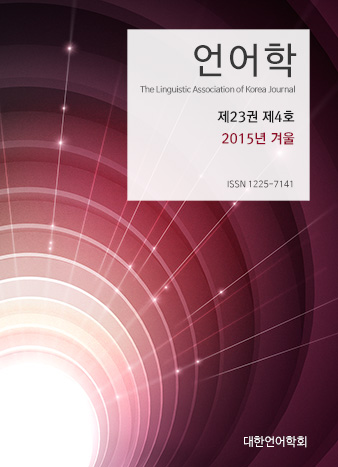대한언어학회 전자저널

23권 4호 (2015년 12월)
- A Study of Mapping Between a Source Domain and a Target Domain in Food-Related Metaphors
-
Heechul Lee ‧ Chonghyuck Kim
Pages : 131-147
Abstract
Lee, Heechul & Kim, Chonghyuck. (2015). A Study of Mapping Between a Source Domain and a Target Domain in Food-Related Metaphors. The Linguistic Association of Korea Journal 23(4), 131-147. There are many expressions based on such food-related metaphors in Korean as HUMANS ARE FOOD, DEALING WITH HUMANS IS COOKING FOOD, HUMAN DISPOSITION IS FOOD TASTE, TYPES OF HUMAN EMOTIONS ARE WAYS OF FOOD INTAKE, HUMAN EXPERIENCES ARE FOOD TASTE, QUALITIES OF IDEAS ARE CONDITIONS OF FOOD, etc. (cf. Choi, 2014). The purpose of this paper is to show that these seemingly individual and isolated metaphors correlate highly with one another and to reach generalizations about some food-related metaphors in Korean. To this end, this research will exploit not only mapping processes between a source semantic domain and a target one, but also sub-mapping and sub-sub-mapping as in Khajeh and Abdullah (2012). The separate food-related metaphors mentioned above will be generalized, mapping the source domain of food onto the target domain of humans as a multi-dimensional structured whole.
Keywords
# food metaphors # mapping # source domain # target domain
References
- Casad, E. H. (1996). Introduction. In E. H. Casad, (Ed.), Cognitive linguistics in the redwoods: The expansion of a new paradigm in linguistics (pp. 1-24), Berlin: Mouton de Gruyter.
- Choi, Y. (2014). Food as a source domain of metaphor in Korean and English. The Linguistic Association of Korea Journal, 22(4). 121-141.
- Hong, S.-H. (2008). Cincca gyengcaynglyekun guwke sillyekita. Goyang, Gyenggi: Wisdom House.
- Khajeh, Z., & Abdullah, I.-H. (2012). Persian culinary metaphors: A cross-cultural conceptualization. GEMA OnlineTM. Journal of Language Studies, 12(1), 69-87.
- Lakoff, G. (1987). Women, fire, and dangerous things. Chicago: University of Chicago Press.
- Lakoff, G., & Johnson, M. (1980a). Metaphors we live by. Chicago: University of Chicago Press.
- Lakoff, G., & Johnson, M. (1980b). Conceptual metaphor in everyday language. Journal of Philosophy, 77(8), 453-486.
- Lakoff, G., & Johnson, M. (2003). Metaphors we live by (2nd ed.). Chicago, IL and London, UK: University of Chicago Press.
- Lim, J.-R. (2003). Aspects of the metaphorical conceptualisation of basic emotions in Korean. Studies in Modern Grammar, 32, 141-167.
- Wittgenstein, L. (1953). Philosophical investigations. New York: Macmillan.
- Yu, N. (2008). Metaphor from body and culture. In R. W. Gibbs, Jr. (Ed.), Metaphor and thought (pp. 247-261). Cambridge: Cambridge University Press.